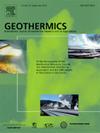Thermal waters in the central part of Baikal Rift Zone: Hydrogeochemistry and geothermometry (Republic of Buryatia, Russia)
IF 3.5
2区 工程技术
Q3 ENERGY & FUELS
引用次数: 0
Abstract
The thermal waters of the Central Baikal Rift Zone are considered in this manuscript. The measured temperatures ranged from 19.8 to 75.6 °C. It was obtained that the studied waters are fresh (TDS 273–941 mg/L), generally weak alkaline and alkaline, enriched with Na+ (77–263 mg/L), SO42- (70–489 mg/L), F- (3.4–19.9 mg/L) and SiO2 (54–118 mg/L) and depleted in Ca2+ (4.65–44.91) and Mg2+ (0.01–0.93 mg/L). The thermal springs mainly belong to SO4-Na and HCO3-SO4-Na chemical types. SO4-Na chemical type was characterized by dominant N2 (89.61–92.20 vol. %) in gas composition, HCO3-SO4-Na type – with N2 (10.72–57.23 vol. %) and CH4 (37.76–71.43 vol. %) predominant gases. The two groups of springs were selected in accordance with TDS, SO42-, HCO3-+CO32-, Ca2+ and Na+. Likewise, the geochemical features of the thermal waters were identified. It was shown that more alkaline waters have lower pH; TDS forms due to SO42- and Na+ accumulation; Cl- and HCO3-+CO32- increased simultaneously, unlike SO42-. Furthermore, F- and SiO2 also increased with pH and temperature, along with a decrease in Ca2+. It was assumed that the thermal waters enriched or depleted in chemical elements depending on the water-rock interaction processes (minerals dissolution/precipitation) and the duration of the water residence in the host rocks. This was illustrated by Cl-/(Cl- + HCO3-) diagram and calculation of ions ratios Na/Cl, HCO3/Cl, Ca/Na, Ca/Mg, Ca/Cl, K/Cl and Mg/Cl. In addition, the reservoir temperatures were estimated using various geothermometers and geoindicators, including the Si-enthalpy diagram. The silica-enthalpy mixing model indicated mixing process only for 7 thermal springs. The analysis of estimated reservoir temperatures using various methods showed that the Si- and K/Mg- geothermometer are more reliable for the studying waters.
贝加尔湖裂谷带中部的热水:水文地球化学和地热测量(布里亚特共和国,俄罗斯)
本文考虑了贝加尔湖中央裂谷区的热水。测量温度范围为19.8至75.6°C。结果表明:所研究的水体为淡水(TDS 273 ~ 941 mg/L),一般为弱碱性和碱性,富集Na+ (77 ~ 263 mg/L)、SO42- (70 ~ 489 mg/L)、F- (3.4 ~ 19.9 mg/L)和SiO2 (54 ~ 118 mg/L),贫Ca2+(4.65 ~ 44.91)和Mg2+ (0.01 ~ 0.93 mg/L)。温泉主要属于SO4-Na和HCO3-SO4-Na化学类型。SO4-Na型以N2 (89.61 ~ 92.20 vol. %)为主,HCO3-SO4-Na型以N2 (10.72 ~ 57.23 vol. %)和CH4 (37.76 ~ 71.43 vol. %)为主。根据TDS、SO42-、HCO3-+CO32-、Ca2+、Na+选择两组弹簧。同时,确定了该区热水的地球化学特征。结果表明,碱性越强的水体pH值越低;TDS的形成是由于SO42-和Na+的积累;与SO42-不同,Cl-和HCO3-+CO32-同时增加。F-和SiO2随pH和温度升高而升高,Ca2+含量降低。假设热水中化学元素的富集或耗尽取决于水岩相互作用过程(矿物溶解/沉淀)和水在宿主岩石中停留的时间。通过Cl-/(Cl- + HCO3-)图和离子比Na/Cl、HCO3/Cl、Ca/Na、Ca/Mg、Ca/Cl、K/Cl和Mg/Cl的计算说明了这一点。此外,利用各种地温计和地质指标(包括si -焓图)估算了储层温度。硅-焓混合模型表明,混合过程仅适用于7个温泉。用各种方法对储层温度的估算分析表明,Si-和K/Mg-地温计对研究水域较为可靠。
本文章由计算机程序翻译,如有差异,请以英文原文为准。
求助全文
约1分钟内获得全文
求助全文
来源期刊

Geothermics
工程技术-地球科学综合
CiteScore
7.70
自引率
15.40%
发文量
237
审稿时长
4.5 months
期刊介绍:
Geothermics is an international journal devoted to the research and development of geothermal energy. The International Board of Editors of Geothermics, which comprises specialists in the various aspects of geothermal resources, exploration and development, guarantees the balanced, comprehensive view of scientific and technological developments in this promising energy field.
It promulgates the state of the art and science of geothermal energy, its exploration and exploitation through a regular exchange of information from all parts of the world. The journal publishes articles dealing with the theory, exploration techniques and all aspects of the utilization of geothermal resources. Geothermics serves as the scientific house, or exchange medium, through which the growing community of geothermal specialists can provide and receive information.
 求助内容:
求助内容: 应助结果提醒方式:
应助结果提醒方式:


